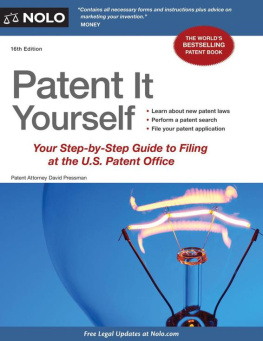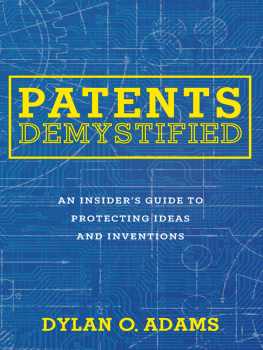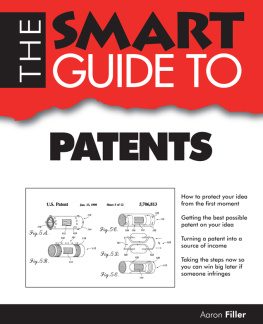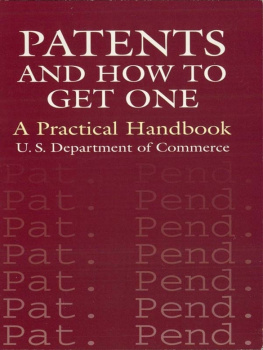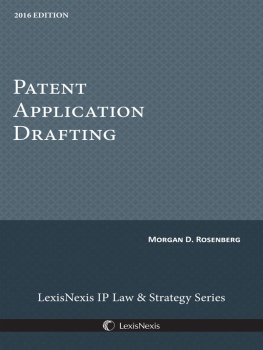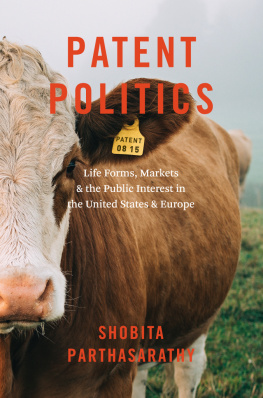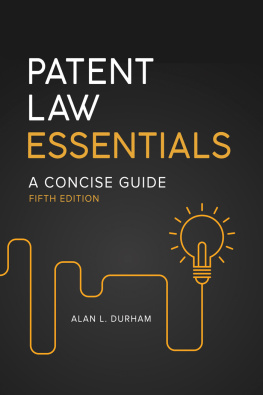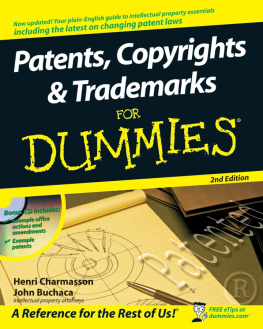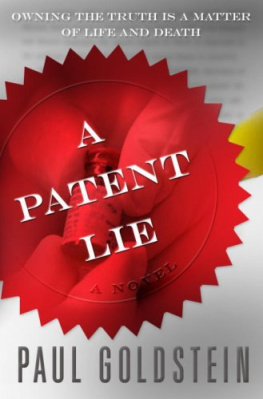
| The Trusted Name (but dont take our word for it) |
In Nolo you can trust.
THE NEW YORK TIMES
Nolo is always there in a jam as the nations premier publisher of do-it-yourself legal books.
NEWSWEEK
Nolo publications... guide people simply through the how, when, where and why of the law.
THE WASHINGTON POST
[Nolos]... material is developed by experienced attorneys who have a knack for making complicated material accessible.
LIBRARY JOURNAL
When it comes to self-help legal stuff, nobody does a better job than Nolo...
USA TODAY
The most prominent U.S. publisher of self-help legal aids.
TIME MAGAZINE
Nolo is a pioneer in both consumer and business self-help books and software.
LOS ANGELES TIMES
16th edition
Patent It
Yourself
Your Step-by-Step Guide to
Filing at the U.S. Patent Office
Patent Attorney David Pressman

SIXTEENTH EDITION | AUGUST 2012 |
Editor | RICHARD STIM |
Cover Design | SUSAN PUTNEY |
Book Design | TERRI HEARSH |
Proofreading | ROBERT WELLS |
Index | JULIE SHAWVAN |
Printing | BANG PRINTING |
International Standard Serial Number (ISSN) : 1554-9925
ISBN: 978-1-4133-1719-0 (pbk)
ISBN: 978-1-4133-1732-9 (epub ebook)
Copyright 1985, 1995, 1996, 1997, 1998, 2000, 2002, 2003, 2004, 2005, 2006, 2008, 2009, 2011, and 2012 by David Pressman.
All rights reserved. The NOLO trademark is registered in the U.S. Patent and Trademark Office. Printed in the U.S.A.
No part of this publication may be reproduced, stored in a retrieval system, or transmitted in any form or by any means, electronic, mechanical, photocopying, recording, or otherwise without prior written permission. Reproduction prohibitions do not apply to the forms contained in this product when reproduced for personal use. For information on bulk purchases or corporate premium sales, please contact the Special Sales Department. Nolo, 950 Parker Street, Berkeley, California 94710.
Please note
We believe accurate, plain-English legal information should help you solve many of your own legal problems. But this text is not a substitute for personalized advice from a knowledgeable lawyer. If you want the help of a trained professionaland well always point out situations in which we think thats a good ideaconsult an attorney licensed to practice in your state.
Acknowledgments
My deep thanks go to my clients, and other inventors whose creativity and genius I so greatly admire and envy. My readers have given me much valuable feedback and suggestions, and I am grateful to them as well.
I also thank the staff at Nolo, including Richard Stim, Steve Elias, Stephanie Harolde, and Ralph Warner for their ideas, contributions, and support, and, especially, Terri Hearsh for substantially improving the look and feel of the book.
Finally, I thank my wife Roberta for her unflagging support and contributions.
About the Author
David Pressman is a member of the California and Patent and Trademark Office bars. Hes had over 45 years experience in the patent profession, as a patent examiner for the U.S. Patent Office, a patent attorney for Philco-Ford Corp., Elco Corp., and Varian Associates, as a columnist for EDN Magazine and Entrepreneur.com, and as an instructor at San Francisco State University. He contributed the Patent, Trademark and Copyright entries to the World Book Encyclopedia. Hes also an inventor, with two patents issued. When not writing, dabbling in electronics, programming, inventing, or playing his trumpet, he practices as a patent lawyer in San Francisco. Originally from Philadelphia, he has a BS in Electrical Engineering from Pennsylvania State University. He spent his first year in law school at the University of Pennsylvania and completed his second and third years at George Washington University, where he served on the Law Review and received a Juris Doctor degree. He is also active in the general semantics and vegetarian movements. His mother, Mildred Phillips, was also a writer, having composed lyrics for numerous published songs, including Bill Haleys Mambo Rock.
Table of Contents
Your Legal Companion
Patent It Yourself is a guidebook that allows you, the inventor, to patent and commercially exploit your invention by yourself. It provides:
instructions for inventing and documenting an invention, and how and when to file a Provisional Patent Application
step-by-step guidance for obtaining a U.S. patent, together with tear-out, copyable, or downloadable forms that are necessary for each step of the process
an overview of the procedures and requirements for getting patent protection abroad and concrete suggestions for finding the necessary resources to help you do this
an overview of the alternative and supplementary forms of protection available for inventions, such as trade secrets, copyrights, trademarks, and unfair competition law, and
detailed information and advice on how to commercially evaluate, market, and license your invention.
One purpose of this book is to save you money. According to the American Intellectual Property Association, the average cost of preparing a minimally complex patent application is approximately $8,500; preparing a relatively complex applicationfor example, an application for a chemical, biotech, mechanics, electronics, or data processing inventioncosts between $11,500 and $15,500. You may not be able to afford these fees, and even if you can, it still pays to do it yourself. By following the instructions set out in this book, youll not only save on attorney fees, but youll be personally involved in every step of the patenting process. After all, you know your invention better than anyone else, and assuming youre willing and able to wade through a number of patent rules and technicalities, youre the best person to patent it.
I think of the book as a great equalizer, since it provides the know-how to enable the garage-shop or basement do-it-yourselfer to get as good a patent as a large corporation. It provides the legal tools necessary for inventors (whether large or small) to provide first-class legal protection for their work. And it especially gives the small inventor the tools to competently and efficiently protect an invention, whether or not he or she can afford a patent attorney.
A. You Dont Have to Use a Patent Attorney
In this view, many inventors believe that one must use a patent attorney to get a valid patent. This isnt true. First, the laws contain absolutely no requirement that one must have a patent attorney to file a patent application, deal with the PTO concerning the application, or to obtain the patent. In fact, PTO regulations (

